Quantitation of per- and polyfluoroalkyl substances (PFAS) in textiles
Sabarinathan1, Sashank Pillai1, Craig M. Butt2
1SCIEX, India; 2SCIEX, USA
Abstract
This technical note describes the analysis of per- and polyfluoroalkyl substances (PFAS) in textiles using the SCIEX 6500+ system. In-sample equivalent limits of quantitation (LOQs) ranged between 25 pg/g and 125 pg/g except for PFBA (5000 pg/g) and NFDHA (1250 pg/g). Matrix spikes were performed at 0.25, 5 and 25 ng/g using a cotton shirt that did not contain background PFAS levels, Overall, the matrix spikes showed excellent recovery (95.4–131%) and precision (%CV 3.1– 28%) at the 0.25 ng/g spiking level. The method was applied to four locally purchased clothing pieces. PFPeA, PFHxA, 4:2 FTS, and 6:2 FTS were detected in the clothing at low ng/g levels.
Key benefits of the SCIEX 6500+ system for PFAS quantitation in textiles
- Mid-range pg/g sensitivity using the SCIEX 6500+ system: In-sample equivalent LOQs ranged from 25 to 125 pg/g for all target PFAS, except for PFBA (5000 pg/g) and NFDHA (1250 pg/g).
- Good quantitative performance in matrix spikes: Matrix spikes at 5 and 25 ng/g demonstrated recoveries of 100±10% and precision %CV <10%. The 0.25 ng/g spike showed accuracy from 95% to 131% and precision %CV <28%.
- Method applicability in purchased clothing: Low ng/g levels of PFPeA, PFHxA, 4:2 FTS, and 6:2 FTS were detected.
Figure 1. Extracted ion chromatograms (XICs) of PFPeA, PFHxA, 4:2 FTS and 6:2 FTS detected in clothing sample #1.
Introduction
PFAS are widely used on textiles due to their durability and unique ability to repel both oil- and water-based stains. It has been estimated that textile applications are responsible for ~35% of the total global PFAS demand.1 A broad range of PFAS compounds have been detected in textiles, demonstrating their extensive use and persistence in commercial products.2,3 PFAS may be released to the environment during all stages of the textile lifecycle, including during initial manufacture, product application, product wear such as leaching and abrasion, and final disposal or recycling. Therefore, the textile industry may represent a diverse and significant source of PFAS contamination to the soil, water and air. Further, textiles are predominately manufactured in Asia and exported worldwide, representing a potential mechanism of global PFAS contamination distribution.
Due to their high usage and potential human health effects, many governments have implemented PFAS textile bans. For example, California and New York have banned the sale of PFAS in various apparel and textiles, effective January 1, 2025.4,5 In the European Union, Denmark and France announced their intention to ban PFAS in textiles.6 Further, the EU PFAS Restriction Proposal aims to significantly reduce PFAS manufacture, use and import from all products, including textiles. Therefore, a sensitive, accurate and precise method is needed to analyze PFAS in textiles.
Methods
Samples and reagents: The calibration standard mixture was purchased from LGC Standards and the stable-isotope internal standard mixture was purchased from Cambridge Isotope Laboratories.
Sample preparation: A 5 x 5 cm (1 g) portion was cut from the textile sample and placed in a 50 mL polypropylene tube. The internal standard mixture was spiked (final concentration = 2.5 ng/g) and 20 mL of methanol with 0.5% (v/v) formic acid was added. The vial was vortexed thoroughly, sonicated for 30 min, vortexed again and centrifuged at 4500 rpm for 20 min. After centrifugation, an aliquot was transferred to a clean vial and diluted 5-fold with 0.5% (v/v) formic acid in water to yield a final solvent composition of 80:20 (v/v) water: methanol.
LC chromatography: Chromatographic separation was performed using an ExionAD LC system. A Phenomenex Luna Omega PS C18 column was used as the analytical (3 µm, 100 x 2.1 mm, P/N: 00D-4758-AN) and delay (5 µm, 50 x 3 mm, P/N: 00B-4753-Y0) columns. Mobile phase A was water with 5mM ammonium acetate, and mobile phase B was methanol with 5 mM ammonium acetate. The gradient conditions used are presented in Table 1. The flow rate was 600 µL/min, the injection volume was 20 µL, and the column oven was 40oC.
Mass spectrometry: Samples were analyzed using the QTRAP 6500+ system with electrospray ionization operating in negative mode. Data was acquired using the scheduled multiple reaction monitoring (MRM) algorithm with optimized source and gas conditions (Table 2) and compound-specific parameters (Table 6 in the Appendix).
Data processing: Data acquisition and processing were performed using SCIEX OS software (version 3.1.6.44).
Table 1: Chromatographic gradient for the analysis of PFAS in textiles.
Table 2: Source and gas parameters for the analysis of PFAS in textiles using the QTRAP 6500+ system.
Sensitivity, precision, and linear dynamic range of the solvent-based calibration standards
The sensitivity, accuracy, precision and linear dynamic range of the QTRAP 6500+ system was evaluated through triplicate injections of the solvent-based calibration standards. Overall, the in-vial LOQs were at low pg/mL levels, ranging from 0.5 pg/mL to 50 pg/mL (Table 3). The notable exception was PFBA, which showed a LOQ of 200 pg/mL due to blank contamination from the internal standard mix and potentially the solvents and consumables used and the general laboratory environment (air, dust). Good quantitative performance was observed at the LOQ level. At the LOQ level, the mean accuracy ranged from 96.2% to 106%, and the mean precision ranged from 4.4%CV to 22%CV. Considering the entire calibration range, the mean accuracy was generally within ±10% of the nominal value. Most PFAS compounds showed 4 orders of linear dynamic range with r2 values >0.99. The LOQ was chosen based on the 2 MRM transitions achieving a signal-to-noise (S/N) ratio of ≥10, accuracy ±10%, precision <10% and ion ratio tolerance of ±30%.
Table 3. Sensitivity, accuracy, precision and linear dynamic range in solvent-based standards (n=3) for PFAS analysis using the QTRAP 6500+ system.
Quantitative performance in textile matrix spikes
Several cotton shirts, one towel and one dhoti were purchased and screened to confirm negligible background PFAS levels for the matrix spike study. Ultimately, no target PFAS analytes were detected in the shirt chosen except for trace levels of 4:2 FTS. Matrix spikes were performed in triplicate at three spiking levels: 0.25 ng/g (low), 5 ng/g (medium) and 25 ng/g (high). Table 4 shows the PFAS recovery and precision for the matrix spikes. Figure 2 shows the PFAS recovery with red dashed lines indicating the 80% and 120% tolerances. Overall, all PFAS compounds showed very good recovery and precision at the 3 spiking levels, demonstrating excellent quantitative method performance. At the 0.25 ng/g spiking level, the mean accuracy was 95.4-131%, and the mean precision was 3.1-28 %CV. The exceptions were NFDHA, which was below the LOQ, and PFBA, which was below the blank level. At the 5 ng/g and 25 ng/g spiking levels, the PFAS recoveries were generally within 100±10% and precision <10%CV. PFBA showed lower recovery due to the relatively high blank levels.
Table 4. PFAS recovery from a cotton shirt spiked at 0.25 ng/g, 5 ng/g and 25 ng/g using the QTRAP 6500+ system. Recoveries were calculated from the quantifier MRM transition.
Figure 2. PFAS recovery from a cotton shirt spiked at 0.25 ng/g, 5 ng/g and 25 ng/g using the QTRAP 6500+ system (n=3 for each spiking level). Recoveries were calculated from the quantifier MRM transition. The low spike for NFDHA was not detected and has been marked with an “*”. PFBA was omitted since high background levels prevented recovery calculation at the 0.25 ng/g and 5 ng/g levels.
PFAS analysis of purchased clothing
The sample preparation and analysis methods were applied to three shirts and one dhoti purchased from local stores. All garments were labeled as containing PFAS or having stain- and water-repellent properties. Overall, few PFAS were observed in the clothing samples and the detected PFAS included: PFPeA, PFHxA, 4:2 FTS, and 6:2 FTS (Table 5 and Figure 1). Clothing sample #1 contained the highest number of PFAS analytes and the mean levels ranged from 0.14 ng/g for 6:2 FTS to 4.0 ng/g for PFHxA. The highest mean PFAS concentration detected was 12.3 ng/g for PFHxA in sample #2, and this sample also contained trace levels of 6:2 FTS (<LOQ). Clothing sample #4 contained 0.04 ng/g of 4:2 FTS and trace levels of 6:2 FTS (<LOQ). The PFAS concentrations measured in this technical note were consistent with those reported in the literature.2
Although a limited number of clothing samples were analyzed, only short-chain PFAS compounds were detected. This trend is consistent with global PFAS manufacturing practices, which have largely phased out the production of long-chain PFAS (>8 carbons). Previous studies2,3 have shown that volatile PFAS, such as fluorotelomer alcohols (FTOHs) and fluorotelomer methacylates (FTMAcs), comprise the majority of the PFAS burden in textiles. However, these volatile PFAS compounds are either not amenable to electrospray ionization or show very low sensitivity and, therefore, were not included in the current method.
Table 5. PFAS concentration (ng/g) in purchased clothing (n=3).
Conclusion
- A simple extraction method was developed to analyze PFAS in textiles using the 6500+ system
- In-sample equivalent LOQs ranged from 12.5 to 125 pg/g, except PFBA and NFDHA, demonstrating mid-range pg/g sensitivity
- Method quantitative performance was demonstrated in matrix spikes at 0.25, 5 and 25 ng/g. The 0.25 ng/g spike showed accuracy within ±31% and precision <28%, 5 and 25 ng/g spikes showed PFAS recoveries generally within 100±10% and precision <10%CV
- Method applicability was shown by analyzing four purchased clothing items. Low ng/g levels of PFPeA, PFHxA, 4:2 FTS, and 6:2 FTS were detected.
References
- WSP. An assessment on PFAS in textiles in Europe’s circular economy. February 2024. Doc Ref. 70110421 EEA Zero Pollution Framework_SR9_An assessment on PFAS in textiles in Europe’s circular economy.
- Xia, C.; Diamond, M.L.; Peaslee, G.F.; Peng, H.; Blum, A et al. Per- and polyfluoroalkyl substances in North American school uniforms. Environ. Sci. Technol. 2022, 56, 13845-13857. DOI: 10.1021/acs.est.2c02111
- Robel, A.E.; Marshall, K.; Dickinson, M.; Lunderberg, D.; Butt, C. et al. Closing the mass balance on fluorine on papers and textiles. Environ. Sci. Technol. 2017, 51, 9022-9032. DOI: 10.1021/acs.est.7b02080
- New York State Department of Environmental Conservation. PFAS in apparel law. https://dec.ny.gov/environmentalprotection/help-for-businesses/pfas-in-apparel-law (accessed 2025-01-31).
- California Assembly Bill 1817. Product safety: textile articles: perfluoroalkyl and polyfluoroalkyl substances (PFAS). https://legiscan.com/CA/text/AB1817/id/2609117 (accessed 2025-01-31).
- European Environment Agency. PFAS in textiles in Europe’s circular economy. https://www.eea.europa.eu/en/analysis/publications/pfas-intextiles-in-europes-circular-economy (accessed 2025-01- 31).
Table 6: Compound-specific MRM parameters and internal standard assignment for PFAS analysis in textiles using the 6500+ system.
Table 6: Compound-specific MRM parameters and internal standard assignment for PFAS analysis in textiles using the 6500+ system.
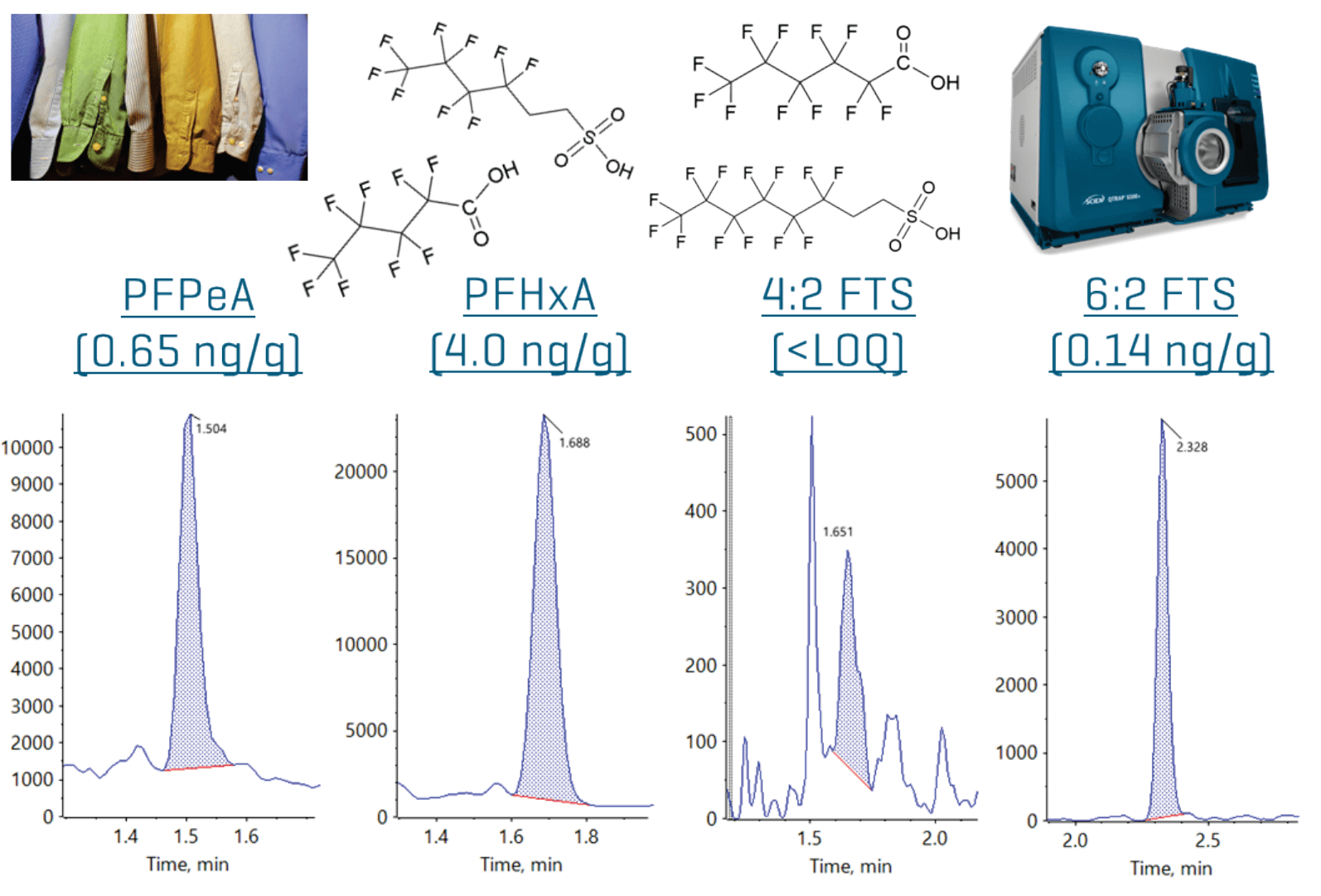 Click to enlarge
Click to enlarge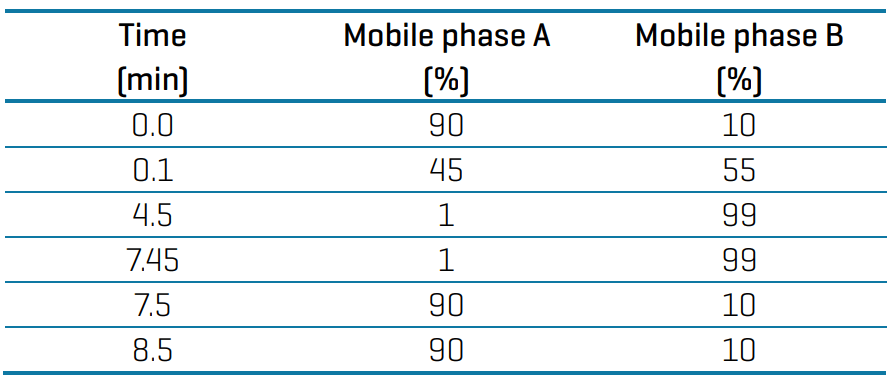 Click to enlarge
Click to enlarge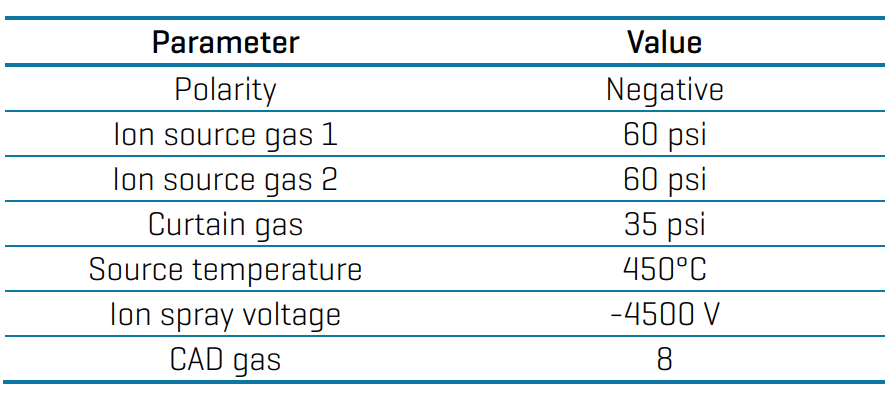 Click to enlarge
Click to enlarge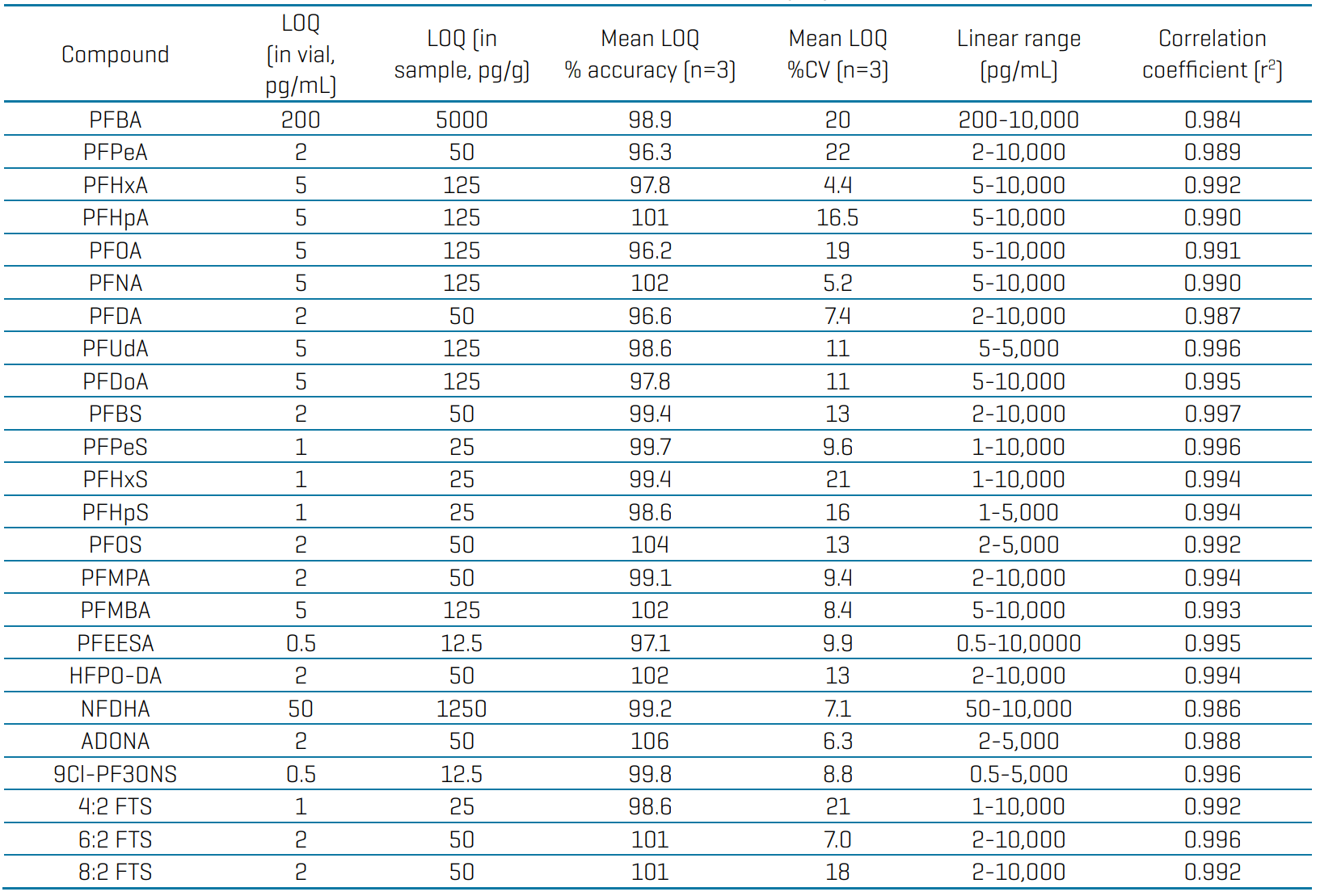 Click to enlarge
Click to enlarge Click to enlarge
Click to enlarge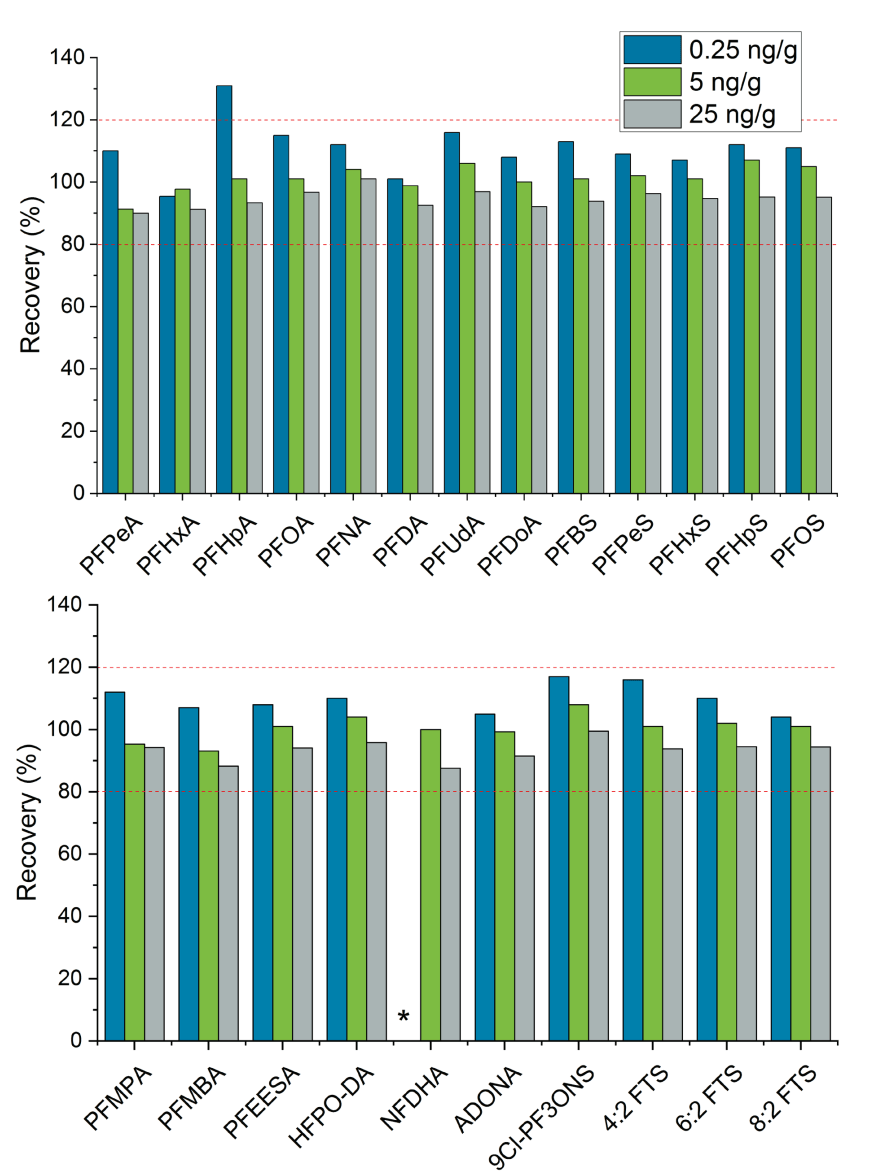 Click to enlarge
Click to enlarge Click to enlarge
Click to enlarge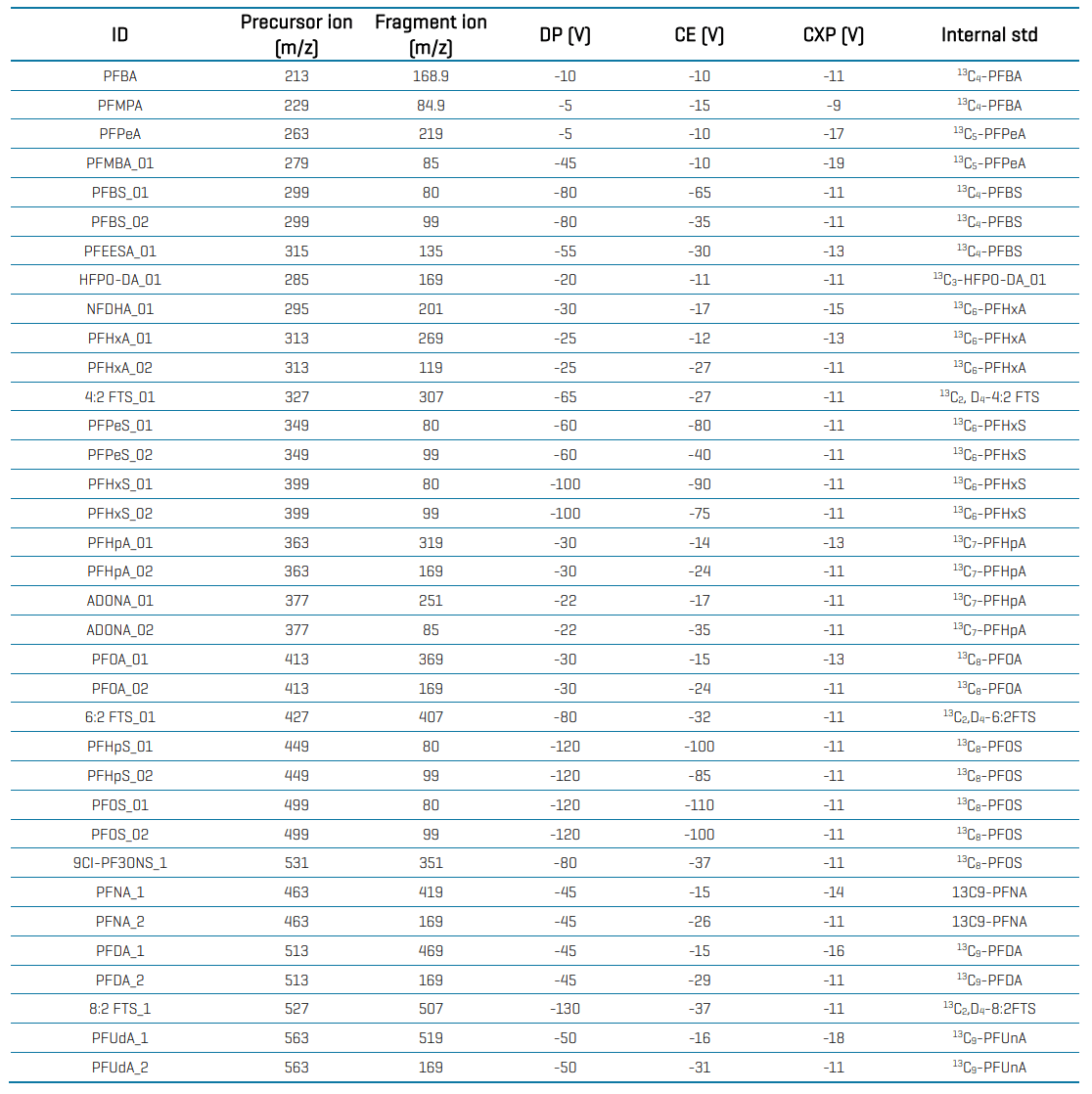 Click to enlarge
Click to enlarge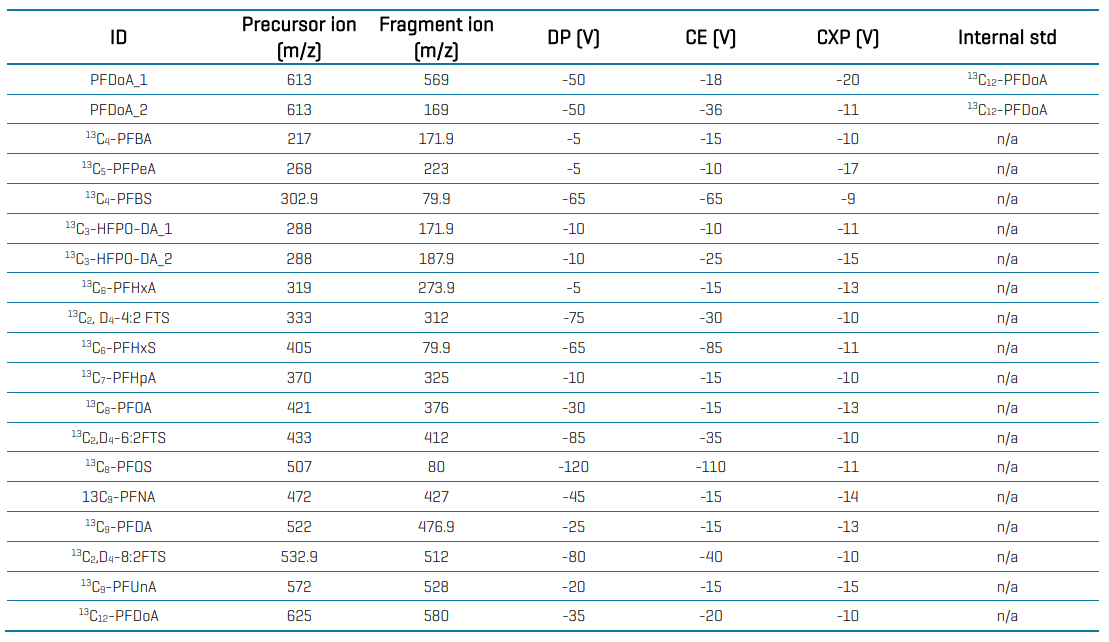 Click to enlarge
Click to enlarge